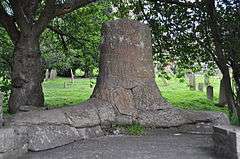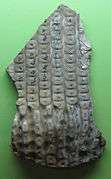Sigillaria
| Sigillaria Temporal range: Carboniferous to Permian | |
|---|---|
 | |
| Sigillaria tree (Stigmaria) from Stanhope, County Durham, UK | |
| Scientific classification | |
| Kingdom: | Plantae |
| Division: | Lycopodiophyta |
| Class: | Isoetopsida |
| Order: | Lepidodendrales |
| Family: | Sigillariaceae |
| Genus: | Sigillaria |
Sigillaria is a genus of extinct, spore-bearing, arborescent (tree-like) plants. It was a lycopodiophyte, and is related to the lycopsids, or club-mosses,[1] but even more closely to quillworts, as was its associate Lepidodendron.
Fossil records
This genus is known in the fossil records from the Late Carboniferous period [2] but dwindled to extinction in the early Permian period (age range: from 383.7 to 254.0 million years ago).[1] Fossils are found in United States, Canada, China, Korea, Tanzania and Zimbabwe.[3]
Species
Species within this genus include:[4]
- S.alveolaris Brongniart (1828)
- S.barbata Weiss (1887)
- S.bicostata Weiss (1887)
- S.boblayi Brongniart (1828)
- S.brardii Brongniart (1828)
- S.cancriformis Weiss (1887)
- S.cristata Sauveur (1848)
- S.cumulata Weiss (1887)
- S.davreuxii Brongniart (1828)
- S.densifolia Brongniart (1836)
- S.elegans Sternberg (1825)
- S.elongata Brongniart (1824)
- S.fossorum Weiss (1887)
- S.hexagona Brongniart (1828)
- S.loricata Weiss (1887)
- S.mammiliaris Brongniart (1824)
- S.menardi Brongniart (1828)
- S.micaudi (Zeller (1886-1888)
- S.monostigma Lesquereux (1866)
- S.orbicularis Brongniart (1828)
- S.ovata Sauveur (1848)
- S.pachyderma Brongniart (1828)
- S.principes Weiss (1881)
- S.reticulata Lesquereux (1860)
- S.rugosa Brongniart (1828)
- S.saulii Brongniart (1836)
- S.schotheimiana Brongniart (1836)
- S.scutellata Brongniart (1822)
- S.sillimanni Brongniart (1828)
- S.tesselata Brongniart (1828)
- S.transversalis Brongniart (1828)
- S.trigona Sternberg (1826)
- S.voltzii Brongniart (1828)
Description
Sigillaria was a tree-like plant reaching a height up to 30 meters,[2] with a tall, single or occasionally forked trunk[1] that lacked wood. Support came from a layer of closely packed leaf bases just below the surface of the trunk, while the center was filled with pith. The long, thin grasslike leaves[5] were attached directly to the stem and grew [2] in a spiral along the trunk.[1] The old leaf bases expanded as the trunk grew in width, and left a diamond-shaped pattern, which is evident in fossils. These leaf scars were arranged in vertical rows.[2] The trunk had photosynthetic tissue on the surface, meaning that it was probably green.
The trunk was topped with a plume of long, grass-like, microphyllous leaves,[5] so that the plant looked somewhat like a tall, forked bottle brush. The plant bore its spores (not seeds) in cone-like structures [5] attached to the stem.[1][6]
Sigillaria, like many ancient lycopods, had a relatively short life cycle - growing rapidly and reaching maturity in a few years. Some researchers have suggested that Sigillaria was monocarpic, meaning that it died after reproduction, though this is not proven.[5] It was associated with Lepidodendron, the scale tree, in the Carboniferous coal swamps.[2]
Gallery

 Sigillaria (bark) on display at State Museum of Pennsylvania, from Scranton, Lackawanna County, Pennsylvania
Sigillaria (bark) on display at State Museum of Pennsylvania, from Scranton, Lackawanna County, Pennsylvania- Replica of Sigillaria sp. in a laboratory of practices of the Faculty of Sciences of the University of A Coruña
- In situ Lycopsid that is probably Sigillaria from the Pennsylvanian Joggins Formation in Nova Scotia
 Sigillaria Artist's Impression.
Sigillaria Artist's Impression.
Bibliography
- William A. DiMichele, Richard M. Bateman: The Rhizomorphic Lycopsids: A Case-Study in Paleobotanical Classification. Systematic Botany, 1996, Band 21, S. 535-552.
- Thomas N. Taylor, Edith L. Taylor, Michael Krings: Paleobotany. The Biology and Evolution of Fossil Plants. Second Edition, Academic Press 2009, ISBN 978-0-12-373972-8. S. 303-307
- J. W. Sir Dawson - On the structure and affinities of Sigillaria, Calamites and Calamodendron - Paperback – August 16, 2011 ISBN 1175560871
- Silva Pineda, A. (2003). "Flora del Pérmico de la región de Izúcar de Matamoros, Puebla". En Soto, L. A. Agustín Ayala-Castañares: universitario, impulsor de la investigación científica. UNAM. p. 371. ISBN 9789703207893
References
- 1 2 3 4 5 Encyclopaedia Britannica
- 1 2 3 4 5 Hans' Paleobotany Pages - The clubmoss tree Sigillaria
- ↑ Paleobiology Database
- ↑ Hans' Paleobotany Pages - Species of Sigillaria
- 1 2 3 4 Encyclopedia of life
- ↑ Sebastián González, D. and Celia Gutiérrez, M. (2014). El Bosque Petrificado de Olta: 300 millones de años después ISBN 9781312079465
External links
| Wikimedia Commons has media related to Sigillaria. |
